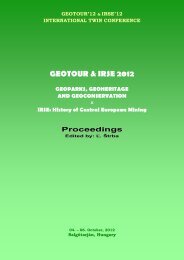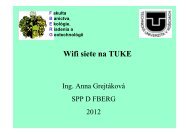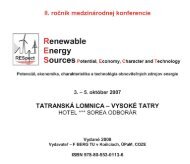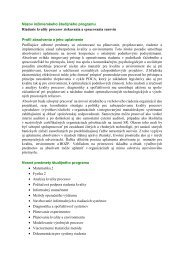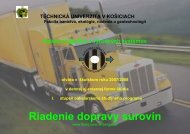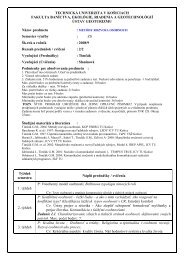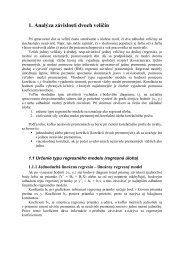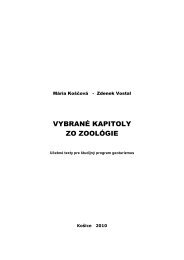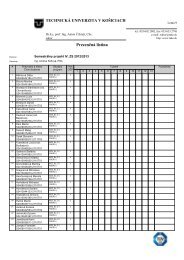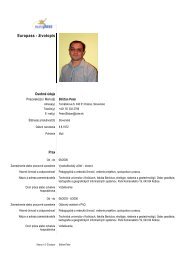GEOTOUR & IRSE 2012.pdf - Fakulta BERG - TUKE
GEOTOUR & IRSE 2012.pdf - Fakulta BERG - TUKE
GEOTOUR & IRSE 2012.pdf - Fakulta BERG - TUKE
You also want an ePaper? Increase the reach of your titles
YUMPU automatically turns print PDFs into web optimized ePapers that Google loves.
Salgótarján, 04. – 06. 2012<br />
of 1000, when the Wrocław bishopric was created and they did not undergo any major<br />
changes throughout the Middle Ages. The south border constituted the massifs of the Sudeten,<br />
the Izerskie Mountains and the Karkonosze Mountains [2]. Despite the complex and turbulent<br />
political history of the Silesia, mining activity has always played an important economic role<br />
here, providing livelihood for their inhabitants and for regional development opportunities.<br />
The origin of many Lower Silesian places is associated with mining. Gold, ores of silver and<br />
lead, copper, tin, arsenic, cobalt chromium, iron, hard coal, brown coal, rock materials, and<br />
even mineral waters constituted and in part still constitute large resources of that region.<br />
However, the subject of interest for former miners were, first of all, numerous, small<br />
polymetallic ore deposits, usually containing a few basic ore minerals, exploited in a<br />
documented manner over the period from the 13th to 20th century [4]. In Lower Silesia, more<br />
precisely in the Sudeten, these types of ore formations encompass a number of deposits and<br />
occurrences characterised by multicomponent and variable mineralisation and the abundance<br />
of occurrence forms. The area of their occurrence is the Sudeten and their foothills, where<br />
certain veins or mineralised zones reach the length of more than 2 km (Radzimowice), and the<br />
depth of more than 300 m (Kowary) [3]. In the initial mining period, first of all the richest and<br />
easily available deposits at small depths have been exploited, and the vein deposits initially<br />
evaluated as abundant often turned out to be small and difficult in exploitation.<br />
Lower Silesia is divided into six main regions in respect of the useful mineral occurrence<br />
These are: Kłodzko Land, Sowie Mountains along with the Wałbrzych region, the foothills of<br />
the Karkonosze Mountains, exploited gold-dust deposits in the vicinity of Lwówek, Złotoryja<br />
and Legnica, the so-called North-Sudeten Zechstein depression (having outcrops south of<br />
Lwówek and Złotoryja and near Grodziec), and Fore-Sudeten Zechstein monocline situated<br />
north of Lubin [4]. The historically known deposits were exploited over many ages and they<br />
were mostly the so-called “open deposits”, i.e. the ore bodies of those deposits were at least<br />
partly exposed by the erosion surface, which allowed their early discovery and extraction [3].<br />
German scientists Cloos, Berg, Bederke and Petrascheck were the first to undertake work<br />
aimed to systematise the information on Lower Silesia deposit occurrence and genesis, in<br />
combination with geological and structural assumptions. In 1936, the comprehensive study<br />
“Schlesien. Bodenschätze und Industrie“, containing the evaluation of geological basis for the<br />
development of mineral extraction and processing within the area of Lower Silesia, was<br />
completed by a group of German scientists and researchers of that period, such as O.<br />
Spangenberg, E. Bederke, O. Eisenkraut, I. Bartsch, L. Gäbler, F. Ilner, A. Metzing, M.<br />
Morgeroth, E. Pralle, D. Rademacher, F.W. Siegert, H. Sinnreich, W. Thust [8]. Since 1945<br />
that work has been intensely continued by the Polish researchers and, among other things, it<br />
has resulted in the discovery of a huge polymetallic deposit of copper and silver, and<br />
consequently in the modern-day boom in the ore mining in Lower Silesia. The deposits on the<br />
Fore-Sudeten monocline, which were discovered only after World War II, are ranked among<br />
the largest in the world and are nowadays intensely exploited in the three modern<br />
underground mines.<br />
The history of Lower Silesian ore mining is well known and mostly associated with the gold<br />
mining which was carried on in many centres and was of special importance to them<br />
[3,4,19,20]. First of all, the area in the former Legnica Duchy, between the rivers Kaczawa<br />
and Bóbr in the region of Lwówek, Złotoryja, Mikołajowice and Bolesławiec was<br />
distinguished by the volume of production. The boom in gold mining took place in the years<br />
1180 – 1241, and only in the first half of the 13th century the mining law was introduced for<br />
the gold mines as one of the earliest in Europe (Lwówek in 1278, Złotoryja in 1342). On the<br />
European scale, Złoty Stok became a recognised centre of gold mining and metallurgy, where<br />
the arsenic ore deposits containing gold were exploited. There, the very beginnings of mining<br />
goes back to 1291, and the largest boom is traced back to 15th century and the first half of the<br />
16th century. Till the end of the 17th century the goal of the mining activity was the<br />
102



